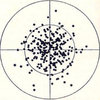spitballer
Member
I've gotten a lot of good reloading advice from this site, especially from the senior members who are quick to point out that a shooter's technique is more important than minor adjustments. Nevertheless I seem to have made a breakthrough with larger groups, and I wonder if I can get any members to corroborate this:
Below are two photos of groups of 20 rounds, shot with a Rem 700 .223 with 12" twist and 55 grain Nosler Ballistic Tip bullets, Nosler cases, CCI #400 primers, and Varget.

The target at the top was from last week. Rounds were charged with 26.4 grains of Varget. Although it's hard to be sure at 400 yards just what is happening, there seems to be a barely discernable 1/2 moa split, with small groups left and right just north of the bull.
The lower target was from this morning. After bumping up the charge to 26.85 gains, the split seems to have been replaced with a single core group. Our senior members will be quick to point out that there are still a lot of rounds that are all over the map, but can anyone verify this phenomenon?
26.85 grains seems to be the lowest charge which will give me a distinct center group, but obviously it's still small: do more rounds collect in the center as the charge increased? Thanks in advance for any anecdotal data or advice regarding this.
Below are two photos of groups of 20 rounds, shot with a Rem 700 .223 with 12" twist and 55 grain Nosler Ballistic Tip bullets, Nosler cases, CCI #400 primers, and Varget.


The target at the top was from last week. Rounds were charged with 26.4 grains of Varget. Although it's hard to be sure at 400 yards just what is happening, there seems to be a barely discernable 1/2 moa split, with small groups left and right just north of the bull.
The lower target was from this morning. After bumping up the charge to 26.85 gains, the split seems to have been replaced with a single core group. Our senior members will be quick to point out that there are still a lot of rounds that are all over the map, but can anyone verify this phenomenon?
26.85 grains seems to be the lowest charge which will give me a distinct center group, but obviously it's still small: do more rounds collect in the center as the charge increased? Thanks in advance for any anecdotal data or advice regarding this.






